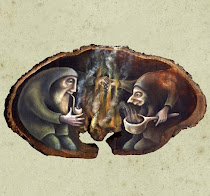
HOTCHI WITCHI he is called by the Gypsies, Pal of the Boor - brother of the hedge. And in my latest clock he crouches shortsightedly amongst the weeds holding up an umbrella clock.
The hedgehog was highly thought of amongst Gypsies, who compared him to themselves because he lives on the fringes of the wild, neither in the open field nor in the deep forest. In addition he is subject to Gorjo (non-gypsy) rumours that he steals eggs, impales apples on his spines to take back to his lair and sucks milk from reclining cows. Hedgehogs also made for the Gypsies a tasty (and free) meal, often roasted in clay over the open fire. The meat is rich and was only shared occasionally. There is tell in folktales that the liver of the hedge brother, a great delicacy, was eaten to overcome deceit and find the truth. Since the hedgehog represented the Gypsy's ideal inner self, the eating of this animal became like a sacred totemic act. To read more about the Hotchiwitchi, there is an interesting chapter in The Traveller-Gypsies by Judith Okely. Here, in a photo from the archive of The Museum of English Rural Life, a Gypsy family outside Snow Hill near Birmingham roast a hedgehog in clay over the fire.
To read more about the Hotchiwitchi, there is an interesting chapter in The Traveller-Gypsies by Judith Okely. Here, in a photo from the archive of The Museum of English Rural Life, a Gypsy family outside Snow Hill near Birmingham roast a hedgehog in clay over the fire.
My Hedge Brother Clock was made for Gina who told me she loved gardens and umbrellas and hedgehogs and who gave it to her husband Jim on the occasion of his sixty-fourth birthday. This little fellow is waiting timidly for the rain I think, under his circus-tent-coloured clock-brolly. He is nestled amid Dürer-inspired weeds.
This clock was made with apple wood again, I think it is the preceding slice from the same tree that bore the hare-violinist. Here you can see even earlier branch intentions.
In my new Hermitage whilst nesting amongst my own weeds I have been industrious with the paintbrush. And in between creating I have been occupied with more prosaic tasks, like collecting a second hand washing machine from a lady in the next village, wrestling with furniture-that-refuses-to ascend-the-steep-and-narrow-stairs, and finding interesting old carpets, brick-a-brack and other magpie delights. I managed to connect the washing machine myself (the first one I have ever owned!) and found in the outlet pipe a dead snail, (a hedgehog feast if ever there was one!) which I removed and put to one side on the windowsill. This morning the "dead" snail was gone! I eventually found him contemplating life half way up a kitchen tile. And there I leave him, and you.
Showing posts with label snail. Show all posts
Showing posts with label snail. Show all posts
Tuesday, 16 March 2010
The Hedge Brother Clock
Written by
Rima Staines
at
10:37 am
60
words from others
![]()
Tags: clock, clockmaking, hedgehog, home, oil painting, once upon o'clock, outsiders, snail
Thursday, 21 August 2008
Snail Water
I LIKE SNAILS. They take their houses with them gypsy-fashion and move at an unhurried pace not dissimilar to my urgency-lacking Rima-drift. I met this spiral-shelled fellow yesterday, making his way round a rain filled ash bucket outside our house. We stopped to chat for a bit and I watched him as he moved slowly down a half submerged piece of slate into the water and back up the other side of the bucket, his eye stalks poking out and in all the while.
The unending rain-rain-day-after-day weather at the moment is probably much more up his street than mine. Everyone is fed up with it. I don't remember what the sun looks like. We've even had mudslides on the road out of the village. When will it end?
I am feeling rather snailish at the moment, slow and sliding through puddles.
Gypsies, incidentally, call snails "earthy-horses" or "cattle" because they have horns, and a snail shell given as a love token by a gypsy girl can stir up an unbridled desire in her intended.
In England, Scotland, Wales and Ireland snails were used as divinatory devices by studying their trails in the hopes of finding there in the slime the initial of your spouse-to-be.
They were also used in cures for warts, the ague (malaria), gout, coughs and earache.
Here below is a recipie for Snail-Water, to treat venereal disease. The photograph is taken from the simply wonderful Old Operating Theatre & Herb Garret - a museum in London Bridge which is reached by a narrow winding staircase up to wooden beamed attic of drying herbs and Jars of Things, terrifying operating implements and skeletons, folk medicines and blood stained wooden operating tables. A treat indeed and well worth a visit.
Snail! snail!
Come out of your hole,
Or else I'll beat you
As black as coal.
Snail! snail!
Put out your horns
I'll give you bread
and barleycorns.
An old nursery rhyme.
Come out of your hole,
Or else I'll beat you
As black as coal.
Snail! snail!
Put out your horns
I'll give you bread
and barleycorns.
An old nursery rhyme.
Written by
Rima Staines
at
11:36 am
26
words from others
![]()
Tags: folklore, gypsy, herbal remedy, old operating theatre and herb garret, rain, snail, snail water
Subscribe to:
Posts (Atom)















































